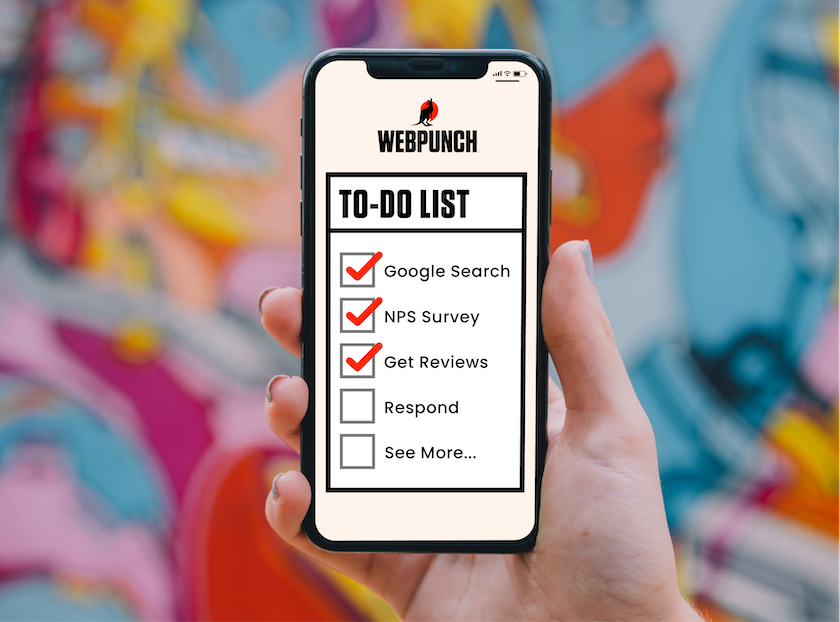What you’ll learn in this piece:
- What an online reputation and online presence are;
- Methods for improving your online reputation management strategy; and
- How WebPunch can help
What’s it all about, Alfie?
Imagine this—You’re perusing the web and you happen to come across something unfavorable about your business. OH NO! Before you sound the alarm, take a step back and think about what could have led to this. It may be time to do damage control, but was there something, anything, you could have done ahead of time to improve your online reputation?
Online reputation management is the strategy you can take to preemptively prevent surprises like this from happening and is something that every business owner must be actively engaged in.
Managing an online reputation is important because a favorable reputation can influence potential customers into choosing your business over a competitor’s.
Google is diligently working in the background to determine your ranking in the SERPs (Search Engine Results Pages). It is also working to compile and rank what is said about you online. Largely, Google’s judgment and how it ranks you are out of your control. However, there are a few things you can do to maximize and improve your online reputation.
Here at WebPunch, we want you to dive into the world of online reputation management with us.
Where should I start? A quick Google search, of course!
A great place to kick off improving your reputation is by Googling your business. See which review sites are listed in the SERPs and focus your attention on building reviews within those sites to boost your rating. Keep in mind that Google should be the number one focus as it is still the leader for reviews and the go-to for information among users. Though, it is important to obtain reviews on other popular sites to confirm the legitimacy of your business.
When looking at the results in the SERPs, are the pages that show up highlighting mostly positive or mostly negative sentiments? Knowing this will serve as kind of a baseline for how you move forward in monitoring your search results.
Next, you’ll want to keep an eye on what is being said on the internet, so you can become aware of a crisis before it escalates. You can do this by creating Google Alerts to notify you in real-time whenever someone mentions your business online.
How to create a Google Alert
First, go to the Google Alert page. In the box at the top of the page, you can enter a topic (in this case, your business’s name) that you want to follow. To get specific about the alert, click on “Show options”. Here you can edit things like how often you get notifications, the location of the alerts, and the language you want to see them in, etc.
Have an NPS survey system in place
A Net Promoter Score (NPS) is a one-question survey sent out to customers immediately after a service is provided. It asks, on a scale of 1 to 10, how much they’d recommend your service to another person. An NPS score helps you understand what kind of experience people have had before they go online to write a review. By using this method, you have a chance to reach out to your customer and address any issues before they decide to take out their feelings in an online review and possibly tarnish your reputation.
After the NPS survey is sent, you can request a review. However, if negative feedback is received from the survey, it’s always a good practice to reach out to the client with a phone call to see how you can make their experience better. We recommend withholding a Review Request until after you’ve reached out to the customer.
NPS surveys and review requests are something WebPunch is able to tackle, and we’d be happy to set these things up for you. We offer a suite of tools to help you listen to your clients, collect and measure client experience data, and knock out your competitors! We specialize in creating segmented data that perfectly fits your unique business needs. Ask us about these services by contacting us here.
Get some reviews to help your online reputation shine!
Even if you don’t send out Review Requests through our system or one of your own, there are plenty of ways to go about requesting, or suggesting, that your clients review your business. Check out How to Get Online Reviews for a plethora of options to go about getting your customers in your corner.
Always keep the ask simple and give them everything they need to complete this task up front—like the links to your review sites!
Respond to every review (negative reviews, too!)
This includes responding to comments on social media sites, and wherever else you can when you find your business’s name mentioned. If you’re getting an influx of negative reviews and they all have the same theme, you know you have a problem and you can work to fix it. This is a great reason to have NPS survey feedback as you can often nip a negative review in the bud by simply Closing The Loop.
When responding to negative reviews, make sure to approach them with a clear mind and a calm demeanor. Your potential customers are looking to see how you handle problems, so you want to make sure your response reflects an air of compassion and kindness. We know this can be difficult, but it’s imperative! You also want to respond quickly, usually within a 24-48 business hour window. People like to be heard and they definitely like to know someone is listening and taking their concerns (or their praise!) seriously.
If you find that a review has violated Google’s content guidelines (or the guidelines of another platform) you can flag the review for removal. We do want to mention that sites like Facebook and behemoths like Google aren’t the best at getting reviews removed. This is where having a well-crafted reply comes in handy.
Responding to reviews will be your biggest defense when mitigating and curating your online reputation.
We recommend that you not engage in a back-and-forth dialogue with a customer who continuously posts negative updates to their review. Respond once. It is also a great idea to call the customer directly to head off any potential issues and back-and-forth discussions they may want to engage in.
But let’s face it—some customers will never be satisfied and will only want to engage in passive-aggressive behaviors. They may never take your phone call or allow you to try and correct their issues and concerns, and may just want to cause havoc on your carefully curated review page. This is where the single, calmly crafted response comes into play. Potential customers will read your response and see that you compassionately responded to the individual’s concerns and that you’re fully capable of handling any problem that comes your way.
Check out our blog on the seven most common types of negative reviews we see and how to respond like a pro to boost your skills in this department.
If you’re stuck in a rut when responding to your own reviews, this is something WebPunch does professionally! We have a team of dedicated, professional writers ready to respond on your behalf. Feel free to inquire about our services here!
Have you secured your name yet?
If you haven’t already, make sure to secure your business’s name across any and all platforms. This includes making pages on Facebook, Instagram, Google, Yelp, Twitter, and even sites like Angi’s and HomeAdvisor if you offer those kinds of services.
Making sure you have control over your business’s name is a crucial part of managing your online reputation. You’ve heard stories about web domains being bought under someone’s nose and then ransomed for big money, right? While that may be an unlikely worst-case scenario, making sure you have your social media handles and pages under your control will help you stay on top of what is being put out into the great wide interwebs.
Publish content consistently
Whether on your website, your social media platforms, or both, make sure you’re consistently publishing content. When you do this, you’re letting Google know that your brand is constantly creating fresh content for it to crawl (crawl = discover and rank).
Some ideas for great and positive content include case studies, statistics, memes, and holidays (if they pertain to your business and brand), to put the focus of your online reputation in your control.
By constantly creating fresh content, you’re showing the world that you’re paying attention to what is going on with your business and your customers.
A tip for social media—make sure what you’re putting out into the worldwide interwebs falls in line with your brand’s message or mission statement.
Do you feel equipped to manage your online reputation?
A positive online reputation cannot be created overnight. It is crafted through time and careful curation.
We’ve listed several ways to tackle managing your online reputation. We hope these tactics will put you ahead of your competition! As always, feel free to contact us if you’d like a little extra help in your corner.

Beth Nintzel
Beth Nintzel is a dedicated member of the WebPunch Review Response Team. She's also an actor in Los Angeles, CA where she lives with her chonky cat, Ophelia. A cat woman at heart, she enjoys spreading out in the sunshine, fitness, and binge-watching great TV shows.


